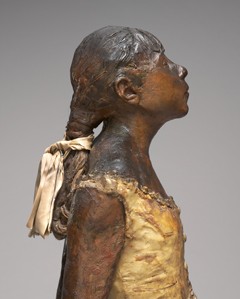Degas’s Famous Sculpture Little Dancer Aged Fourteen Celebrated in Focus Exhibition at National Gallery of Art on Occasion of Kennedy Center’s World-Premiere Musical “Little Dancer” in Fall 2014

Edgar Degas, Little Dancer Aged Fourteen, 1878-1881, detail.
National Gallery of Art, Collection of Mr. and Mrs. Paul Mellon
The National Gallery of Art’s Little Dancer Aged Fourteen (1878–1881) takes center stage in Degas’s Little Dancer, a focus exhibition on view from October 5, 2014 through January 11, 2015. The exhibition is presented in conjunction with the John F. Kennedy Center for the Performing Arts’ world-premiere musical Little Dancer, which runs from October 25, 2014 through November 30, 2014. The musical is inspired by Edgar Degas’s renowned original wax statuette of a young ballerina, which caused a sensation when it was first shown at the 1881 impressionist exhibition in Paris and is one of the most popular works of art in the Gallery of Art’s collection.
“Thanks to the generosity of Gallery benefactor Paul Mellon, the Gallery has the largest and most important collection of Degas’s original wax sculptures, including the groundbreaking Little Dancer Aged Fourteen, one of the best-loved sculptures of all time,” said Earl A. Powell III, director, National Gallery of Art. “Well-known through more than 30 posthumous bronze casts displayed in museums around the world, the Gallery’s wax version of Degas’s famous sculpture is the only one that was formed by the artist’s own hands and the only one he ever showed publicly.”
The Gallery has the third largest collection of Degas works in the world, including 12 cast bronzes, one posthumously produced plaster, 19 paintings, 71 works on paper, and 52 original Degas works in wax, clay, and plaster.
About the Exhibition
Little Dancer Aged Fourteen will be presented with 11 additional works that exemplify Degas’s fascination with the practice and performance of ballet, including the monumental pastel Ballet Scene (c. 1907) and monotype The Ballet Master (c. 1874) from the Gallery’s collection, and oil painting The Dance Class (c. 1873) from the Corcoran Gallery of Art. These works will join the smaller statuettes Study in the Nude of Little Dancer Aged Fourteen (c. 1878–1881) and Fourth Position Front, on the Left Leg (c. 1885/1890), each about two feet tall.
The exhibition also highlights the experimental, modern approach Degas took to his work. Degas did not carve sculpture but used an additive process. Little Dancer was modeled in wax over a metal armature, bulked with organic materials including wood, rope, and even old paintbrushes in the arms. It was then covered with clay and layers of pigmented wax. Degas further elevated the sculpture’s realism by affixing a wig of human hair to the head and outfitting his ballerina in a cotton-and-silk tutu, a real bodice, and linen slippers.
The Ballet Master was likely the artist’s first attempt at monotype, made in collaboration with his friend Viscount Ludovic Napoléon Lepic (1839-1889), who taught Degas this challenging printmaking technique, which produced only a single, lush impression of each image. Degas enhanced the print with white to create an effect of both dancer and ballet master emerging eerily from an inky darkness.
The exhibition features three other monotypes which Degas heightened extensively with pastel. Dynamic and vibrantly colored, they perfectly capture the luminous effect of the gas-lit stages. Degas frequently explored the dancers’ world off-stage, depicting them at rehearsal or standing in the wings, awaiting the start of the performance. He was a keen observer and a wry but sympathetic chronicler of the daily life of the dancers he studied, even on occasion introducing a black-clad gentleman, an abonné (or subscriber), watching from an opera box or lurking behind the scenes as a potential “protector” of the young dancers.
In addition, the exhibition includes a portrait drawing of Degas by his friend, the artist Paul Mathey (1844–1929). In it Degas stands looking at a work of art in a posture loosely recalling that of his Little Dancer muse, arms behind his back, hands clasped.
Degas’s Little Dancer is organized by the National Gallery of Art and curated by Alison Luchs, curator of early European sculpture.
Degas Sculptures: History and Research
Degas made sculpture throughout his life. Contemporaries record that when they visited his studio they were just as likely to find him modeling in wax and clay as they were to find him at the easel. Yet Degas’s obsessive tendency to work and rework his sculptures destroyed some in the process and left others unfinished. Even the Little Dancer was subject to his whim. In 1880, though included in an exhibition program, the sculpture’s case was left empty. When it was finally exhibited, the sculpture appeared two weeks late.
Many critics dismissed Little Dancer as “repulsive” and “a threat to society.” They were accustomed to more traditional female subjects, such as goddesses, allegorical figures, or heroines from literature—not a contemporary, working-class girl in training for a profession with a risky reputation. (These petit rats de l’opéra, or “opera rats,” were viewed by many at the time as subject to moral corruption.) Degas’s unorthodox process and materials, which included human hair, silk ribbon, linen, rope, cork, cotton muslin, and silk tulle, provoked further objections. But Degas endowed his subject with humanity. Poised between girl and woman, the bony figure of the young ballerina is simultaneously vulnerable and proud. Shoulders back and her head held high, her posture is erect and dignified.
Recent discoveries by National Gallery of Art staff have contributed greatly to the understanding of the unconventional materials Degas used in making his sculptures. Through technical study by Shelley G. Sturman, head of object conservation, and Daphne S. Barbour, senior object conservator, as well as scientific analyses by Barbara H. Berrie, senior conservation scientist, Suzanne Quillen Lomax, organic chemist, and Michael Palmer, conservation scientist, it is now known that the artist formed most of his sculptures from such materials as pigmented beeswax and nondrying modeling clays. Degas usually built his own armatures from brass or galvanized-iron wires, and formed the sculptures over them, filling them with anything at hand—cork, paper, rope, and even discarded objects like the lid of a salt shaker or used paint brushes.
These research findings along with exhaustive art historical information on all Degas sculptures in the National Gallery of Art’s collection were published in the landmark systematic catalogEdgar Degas Sculpture by Suzanne G. Lindsay, Shelley G. Sturman, and Daphne S. Barbour, published by the Gallery in 2010 and distributed by Princeton University Press.
Edgar Degas Sculpture can be purchased in the National Gallery of Arts Shops and online at http://shop.nga.gov.
About the Musical
Part fact, part fiction, and set in the harsh backstage world of the Paris Opera Ballet, Little Dancer is inspired by the young ballerina who posed for Degas and became, inadvertently, the most famous dancer in the world. Torn by her family’s poverty, her debt to the artist and the lure of wealthy men, Marie struggles to keep her place in the ballet corps—a girl on the verge of womanhood, caught between the conflicting demands of life and art.
Though fictionalized, the musical also reflects the friendship between Degas and the equally famous impressionist Mary Cassatt, a relationship fully examined for the first time in the exhibition Degas/Cassatt, now on view exclusively at the Gallery through October 5, 2014.
With book and lyrics by Tony Award winner Lynn Ahrens, music by Tony Award winner Stephen Flaherty, and direction and choreography by five-time Tony winner Susan Stroman, the brand-new Kennedy Center musical stars four-time Tony winner Boyd Gaines as Edgar Degas, three-time Tony nominee Rebecca Luker as the adult Marie Van Goethem, and New York City Ballet principal dancer Tiler Peck as the young Marie. Performances for the Kennedy Center production of Little Dancer begin October 25, 2014 and tickets go on sale to the general public on August 6.
General Information
The National Gallery of Art and its Sculpture Garden are at all times free to the public. They are located on the National Mall between 3rd and 9th Streets at Constitution Avenue NW, and are open Monday through Saturday from 10:00 a.m. to 5:00 p.m. and Sunday from 11:00 a.m. to 6:00 p.m. The Gallery is closed on December 25 and January 1. With the exception of the atrium and library, the galleries in the East Building will remain closed for approximately three years for Master Facilities Plan and renovations. For specific updates on gallery closings, visithttp://www.nga.gov/content/ngaweb/Collection/modern-art-during-renovation.html.
For information call (202) 737-4215 or the Telecommunications Device for the Deaf (TDD) at (202) 842-6176, or visit the Gallery’s Web site at www.nga.gov. Follow the Gallery on Facebook at www.facebook.com/NationalGalleryofArt and on Twitter at www.twitter.com/ngadc.
Visitors will be asked to present all carried items for inspection upon entering. Checkrooms are free of charge and located at each entrance. Luggage and other oversized bags must be presented at the 4th Street entrances to the East or West Building to permit x-ray screening and must be deposited in the checkrooms at those entrances. For the safety of visitors and the works of art, nothing may be carried into the Gallery on a visitor’s back. Any bag or other items that cannot be carried reasonably and safely in some other manner must be left in the checkrooms. Items larger than 17 by 26 inches cannot be accepted by the Gallery or its checkrooms.
